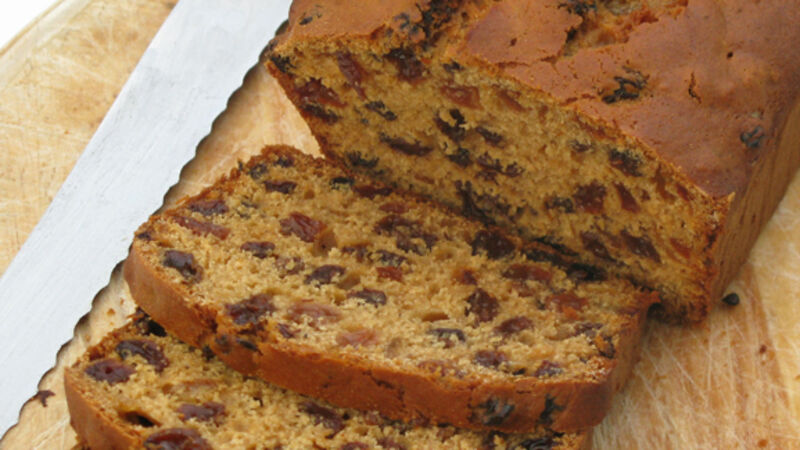Ballymaloe Halloween Barmbrack

Mexico’s Day of the Dead celebrations are the most colourful and flamboyant, it’s a huge festival, celebrated by Mexicans all over the world. Common traditions include creating altars, Ofrenda, in the home to honour the dead, laying out offerings, sharing stories and reminiscences and visiting and cleaning the graves.
This is a convivial rather than sombre affair with relatives bringing the favourite foods of the deceased to the graveyard to share a picnic with relatives and friends as they share memories of their loved ones. For non-Mexicans their first introduction to the Day of the Dead seems spooky and macabre. Colourful skeletons, bones and skulls decorate both homes and food. The tradition of making sugar skulls, calaveras de azucar, endures. These gaily decorated vibrant candied skulls are not considered to be creepy or morbid, instead they are happy , even smiling or laughing, embellished with eye popping colours, hot pinks, neon blue, bright yellow, vivid orange, glowing green…. They can be further decorated with glitter, sequins, beads, rhinestones, feathers, shiny foil and googly eyes, anything that will stick to the icing. Female skulls can be adorned with paper hats, male with cowboy or sailor hats. There’s a lot of room for creativity, but they are rarely eaten. Sugar skulls are placed on the altar and last for up to year. Check out Pinterest for a feast of colour.
Other Day of the Dead foods are Pan de Muerto, traditional Mexican sweet bread which is made in a variety of ways across different regions of Mexico. It’s easy to make but takes time and again can be decorated in a myriad of styles with bones and skulls and sparkly sugar on colourful icing. In Spain, Halloween is a three day celebration, starting on October 31 every year. The first is, Dia de las Brujas or Day of the Witches, this is also called Samhain or Noite des Calacus, Night of the Pumpkins in Galicia. This is followed by Dia de Todos los Santos, all Saints Day and finally on November 2, the customs and rituals of Dia de los Muertos, All Saints day, are observed as in Mexico. Halloween is not just about the dead it’s also celebration of the continuity of life. Once again there are specific foods and drinks including one made from herbs and set alight to chase away the evil spirits, called quemadas. Here in Ireland, Halloween festivities gather momentum every year.
As with Christmas, the original raison d’être is all but forgotten in the frenzy of ‘trick or treating’ but still local bakers mark the festival by adding the traditional ring to a fruity yeasted bread called barmbrack and maybe a stick, a pea and a piece of rag for added excitement. In our house we also eat colcannon made with the early kale – traditionally eaten in Ireland and Scotland, a little bowl was put outside on a window sill to ward away the evil spirits. It’s comfort food at it’s best.
This little gem of a recipe is much easier to make at home than the bakers Halloween Barmbrack made with yeast.
450g (1lb) loaf tin, 12.5 x 20cm (5 x 8in) OR 3 small loaf tins 15 x 7.5cm (6 x 3in)
Put the dried fruit and cherries into a bowl. Cover with hot tea and leave to plump up overnight.
Next day, line the loaf tin with silicone paper. Preheat the oven to 180C/350F/gas mark 4.
Add the whisked egg, soft brown sugar, flour and mixed spice to the fruit and tea mixture. Stir well. Put the mixture into the lined loaf tin.
Cook in for about 1½ hours or until a skewer comes out clean.
Leave to cool on a wire rack. Keeps very well in an airtight tin.
Fruit should be organic if possible, otherwise scrub the peel well. Use 5 organic unwaxed oranges; 5 organic unwaxed lemons; 5 organic unwaxed grapefruit (or all of one fruit); some water, a teaspoon of salt and 3lbs (1.35kg) sugar.
Cut the fruit in half and squeeze out the juice. Put the peel into a large bowl (not aluminium), add salt and cover with cold water. Leave to soak for 24 hours.
The following day throw away the soaking water, put the peel in a saucepan and cover with fresh cold water. Bring to the boil, cover and simmer very gently until the peel is soft, three hours approx. Remove the peel and discard the water. Scrape out any remaining flesh and membranes from inside the cut fruit, leaving the white pith and rind intact. (You could do the next step the following day if that was more convenient).
Slice the peel into nice long strips. Alternatively cut each half in half.
Dissolve the sugar in 1¼pints (750ml) of water, bring it to the boil, add the peel and simmer gently until it looks translucent, 30–60 minutes, and the syrup forms a thread when the last drop falls off a metal spoon. Remove the peel with a slotted spoon, fill the candied peel into sterilised glass jars and pour the syrup over. Cover and store in a cold place or in a fridge. It should keep for 6-8 weeks or longer under refrigeration.
Alternatively spread on a baking tray or trays and allow to sit for 30 minutes to one hour to cool. Toss in caster sugar and store in covered glass jars until needed.
Colcannon was one of the festive dishes eaten at Halloween, when a ring and a thimble would be hidden in the fluffy green-flecked mass. The ring denotes marriage, but the person who found the thimble would be a spinster for life. Poems would have been written and songs sung about this much-loved dish.
Threepenny or sixpenny bits were sometimes hidden in the colcannon at Halloween for children to find.
Scrub the potatoes, put them in a saucepan of cold water, add a good pinch of salt and bring to the boil.
When the potatoes are half-cooked after about 15 minutes, strain off two-thirds of the water, replace the lid on the saucepan and put onto a gentle heat, leaving the potatoes to steam until they are cooked.
Meanwhile, if using cabbage, remove the dark outer leaves, wash the remainder, cut it into quarters, remove the core and cut finely across the grain.
Cook in a little boiling water or bacon cooking water until soft. Drain and season with salt, freshly ground pepper and a little butter.
When the potatoes are just cooked, put the milk and the finely chopped shallots into a saucepan and bring to the boil.
Pull the peel off the potatoes and discard. Mash the potatoes quickly, while they are still warm, and beat in enough boiling milk to make a fluffy purée. (If you have a large quantity, put the potatoes in the bowl of a food mixer and beat with the spade.) Then stir in the cooked cabbage and taste for seasoning.
For perfection, serve immediately in a hot dish with a lump of butter melting in the centre.
Colcannon may be prepared ahead up to this point and reheated later in a moderate oven 180ºC/350ºF/gas mark 4, for 20–25 minutes. Cover while reheating so it doesn’t get too crusty on top.
This rich, moist chocolate cake is made with whole almonds and, like many of the cakes they bake at Buenvino, it uses no flour.
Serves 8-12
Preheat the oven to 180C/350F/regalo 4. Line the bases of two 20cm (8in) cake tins with greaseproof or silicone paper. Brush the base and side with butter and dust with a little flour, turning to coat the tin and tapping out the excess.
Melt the chocolate with the brandy in a heatproof bowl over barely simmering water. Let cool. Grind the almonds in a food processor; they should be left a little gritty, not ground to a paste.
In a separate bowl, cream the butter and the 115g (4oz) of sugar, beating until light and fluffy. Beat in the egg yolks one by one.
In a third bowl, beat the egg whites until stiff, then add the 1 tablespoon of sugar and continue whisking until stiff peaks form. Add the melted, cooled chocolate to the butter mixture with half the ground almonds. Fold in the egg whites, followed by the remaining almonds; then the remaining egg white.
Divide the mixture between the prepared tins and make a dip in the centre of each cake. Bake in the oven for 20-25 minutes. The cake should be moist and slightly unset at the centre.
Allow to cool for a few minutes, and then turn out onto a wire rack, remove the papers and allow to get cold.
For the icing, melt the chocolate, icing sugar and brandy in a heatproof bowl over simmering water, then whisk in the butter bit by bit. Remove from the heart and whisk occasionally until cool.
When the cake is cold, fill and ice it with the chocolate icing.
To decorate, make a stencil of a witch or a pumpkin, lay on top of the cake and dust with icing sugar.
Delicious with a chilled glass of pale cream sherry.
Feel like an Autumn break? Can’t imagine anywhere lovelier that Finca Buenvino near Aracena in Andalucía. In the midst of oak forests where free-range Iberian pigs destined for pata negra, gorge on acorns and then there’s Jeannie’s food which is beyond delicious. Check out www.fincabuenvino.com
West Cork Garlic: Writing about Halloween reminded me that vampires abhor garlic or so I’m told! Bryan Perrin grows 10 different varieties of garlic with origins in many parts of Europe and Asia on the fertile land in and around the 16th Century ruins of Ballinacarriga Castle near Dunmanway in West Cork. It is sold in local farmers’ markets, supermarkets and wholefood shops.They also sell garlic seed and will offer advice on growing. Traditionally garlic was planted on the shortest day of the year, December 21, and harvested on the longest June 21 — you may need to adjust that slightly now with global warming. Contact Bryan@westcorkgarlic.com or 087 133 3751 for your nearest stockist or growing advice.
Craft Beer and food pairing is all the rage. It is so brilliant to have a selection of craft beers at last. Guess where you can get a really well chosen selection? At Number 21, a little off licence tucked in behind the Lakeview filling station in Midleton, there’s another in Coburg Street in Cork and also in Charleville.
Contact them on 021-4638444, Twitter:@no21midleton or Facebook: Number 21 Midleton.
presents “You are What Your Mother Eats” with Cora Doherty, Neonatologist, University Hospital of Wales, Cardiff. Ballymaloe Cookery School, Tuesday October 28th at 7pm. Contact slowfoodeastcork@gmail.com
021 4646785











